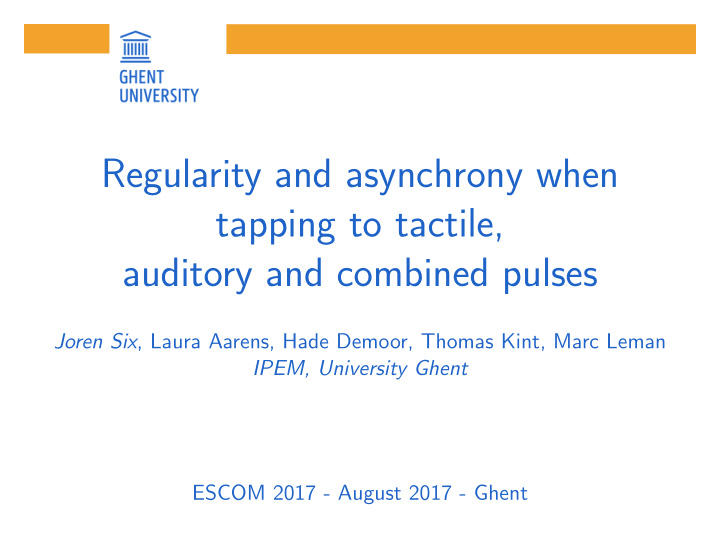



Regularity and asynchrony when tapping to tactile, auditory and combined pulses Joren Six , Laura Aarens, Hade Demoor, Thomas Kint, Marc Leman IPEM, University Ghent ESCOM 2017 - August 2017 - Ghent
Overview I Context Feedback modality Feedback synchronization Feedback timing Problem - Multimodal processing Experimental results Regularity Asynchrony Asynchrony Discussion Bibliography 2/23
Context How to dance the tango without being able to follow the beat. For: ◦ Early-deafened late-implanted adult cochlear implant users [2] ◦ People with beat deafness[3] Figure: Tango lesson. 3/23
Context How to dance the tango without being able to follow the beat. Emphasize beats using a non-sound modality. × Which feedback modality? × How to provide feedback events in sync with music? × When to provide this feedback? 4/23
Feedback modality Which feedback modality? × Visual feedback is distracting and obtrusive. × Perception of smell is slow. × Taste is unpractical. → Tactile feedback can be fast, wearable and inconspicuous. 5/23
Feedback modality � Which feedback modality? × How to provide feedback events in sync with music? × When to provide this feedback? 6/23
Feedback synchronization Figure: Schema of beat feedback technology. Demo-movie, More details in [5] 7/23
Feedback synchronization � Which feedback modality? � How to provide feedback events in sync with music? × When to provide this feedback? 8/23
Problem - Multimodal processing We want to provide: ◦ tactile feedback ◦ in musical tempi (90-150BPM) ◦ perceived at the same time as audible beats 9/23
Problem - Multimodal processing Only limited literature on multisensory integration available [4, 1] When exactly to provide tactile feedback? Specific experiment seemed required. 10/23
Method - Tapping experiment Subjects: 27 subjects, 3 CI users Set-Up: A table with a drum in quiet room Procedure: Tap along with stimulus at 90, 120 or 150BPM. Auditory stimulus Continuous vs discrete Tactile stimulus Rigid vs Micro-timing Combined auditory and tactile stimulus 11/23
Method - Tapping experiment Figure: Measurement schema set-up. 12/23
Method - Tapping experiment Figure: Micro-controller for precise measurement. 13/23
Method - Tapping experiment Figure: Experimental data includes regularity (vector size) and asynchrony (angle). 14/23
Regularity Definition Regularity quantifies the differences in repeated inter event intervals. Main effects were found for Tempo, Sound and Stimulus No significant effect between auditory vs auditory + tactile, suggestive 15/23
Asynchrony Definition Asynchrony quantifies the time differences between actual and expected events. Main effects were found for Tempo and Stimulus 16/23
Asynchrony 100 Auditory Tap after beat (ms) +- STD Tactile Combined 50 0 − 50 − 100 Slow Medium Fast Figure: Asynchrony for tactile pulses seems tempo dependent - from anticipatory to reactionary behavior. 17/23
Discussion Suggests an assistive technology should modify tactile feedback dependent on tempo. Figure: Simplified model of total system delay, the contribution of each sub-system is unknown. The red line shows the ideal sync point. 18/23
Discussion Are late implanted CI-users able to dance? Motion capture study? Insights into multisensory integration processes. 19/23
Bibliography I Mark T Elliott, AM Wing, and AE Welchman. Multisensory cues improve sensorimotor synchronisation. European Journal of Neuroscience , 31(10):1828–1835, 2010. Christina Fuller, Lisa Mallinckrodt, Bert Maat, Deniz Baskent, and Rolien Free. Music and quality of life in early-deafened late-implanted adult cochlear implant users. Otology & Neurotology , 34(6):1041–1047, 2013. 20/23
Bibliography II Jessica Phillips-Silver, Petri Toiviainen, Nathalie Gosselin, Olivier Pich´ e, Sylvie Nozaradan, Caroline Palmer, and Isabelle Peretz. Born to dance but beat deaf: a new form of congenital amusia. Neuropsychologia , 49(5):961–969, 2011. Bruno H Repp and Yi-Huang Su. Sensorimotor synchronization: a review of recent research (2006–2012). Psychonomic bulletin & review , 20(3):403–452, 2013. 21/23
Bibliography III Joren Six and Marc Leman. A framework to provide fine-grained time-dependent context for active listening experiences. In Proceedings of the AES Conference on Semantic Audio 2017 , 2017. 22/23
Inconclusive tapping performance Auditory 100 Tactile Tap after beat (ms) +- STD Combined 50 0 − 50 − 100 Slow Medium Fast 23/23 Figure: Inconclusive tapping performance by three CI users.
Recommend
More recommend